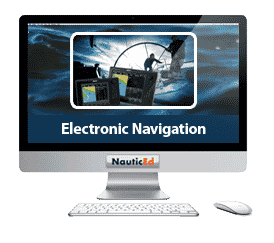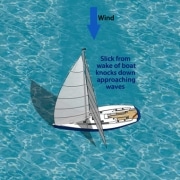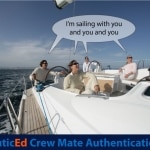How to Effectively use a Wind Meter on a Sailboat
Using a Wind Meter – get your head out of the boat
Please consider our awesome Electronic Navigation course. It is also loaded with similar animations to help you understand many of the electronic aids on a sailboat especially your GPS chart plotter, wind meter and autopilot.
First let me state my point of how to use a wind meter in strong language – stop watching the dang wind meter and get your head out of the boat.
Lately I’ve had a great opportunity to be out on the water teaching again and this issue has become very apparent so I’m going to iterate it here so that you get the point. Stop watching the wind meter – get your head out of the boat. And just one more time a little louder ; STOP WATCHING THE WIND METER AND GET YOUR HEAD OUT OF THE BOAT.
If you’re an old hat sailor then you’ll appreciate this article next time you’re out teaching a friend to take the helm. If you’re a new sailor then read on also.
Here is a analogy – imagine you were teaching your daughter to drive a car and you said to speed up to 50 miles per hour. So she put her head down and continued to look at the speedometer until it got to 50 miles per hour. One major thing would happen – you’d never get to 50 miles per hour. You’d be through a fence and upside down talking to the sheep. It is obvious right? Let’s look at what actually happens when you speed up to 50. Starting from say 30 you instantly calculate that you’ve got 20 mph to go so foot goes down while you continue to look at the road ahead. As the car speeds you flick check for 1/4 second at your speed – it’s now 40 – ah ten to go. You hold your foot for a bit longer while LOOKING AT THE ROAD. Another flick 1/4 sec check -45 hmmm only 5 to go – foot starts easing – flick 1/4 sec 48 – foot eases more WHILE LOOKING AT THE ROAD. 50 ahhh good. Now first time drivers might overshoot a little then ease back down then speed up a few times and that is natural – and they will get used to that over time to gain a feel for how the car reacts. As an old time driver – even given a formula one car I beat you could get it to 50 easily. BUT you would have done it by keeping your eyes on the road. You would not think of watching the speedo – you flick check 1/4 sec each time and make decisions and adjustments based on how far or close you are to the desired speed mark.
SO WHY DO NEW SAILORS WATCH THE WIND METER? (STOP IT BTW)
The reason new sailors watch the wind meter is that they are transfixed by it. Their brain is trying to process and calculate which way do they turn the wheel or tiller to make the meter get to the desired place. AND get this – their brain can not possibly calculate it so it transfixes them.
This is the thought process in a brain if you try to calculate it. So the captain said to keep the wind meter on 30 degrees on the meter and the wind is on my left. The meter reads 70 degrees pointing left – if I turn the wheel starboard that will make the meter numbers increase or decrease – hmmm um well lets see straight up and down is dead ahead and the wind is now coming from my left so if i turn the wheel to the right that will make the meter go um bigger um yes that’s right I think so perhaps to the left the meter will go smaller um yes I think so – wait does it? hmmm let me try an experiment … oh wait now the meter is reading 90 oh I steered way to much in the wrong direction but wait why did that happen I thought…
So now lets get into the brain of someone with their head out of the boat watching land and clouds.
- Flick check 1/4 sec – the wind meter is reading 70 and the captain said keep it on 30. So if it is at 70 the wind must be coming from that building on the land over there. The difference between 70 and 30 is 40. 40 degrees from my heading towards that building is that orange roof house. Ok let me aim for that. Like a car I just turn the wheel to aim for that house. Ok I am heading right on that house now.
- Flick check 1/4 sec – the meter reads 40 – oh so I need to go ten more degrees. That tower should do it. Turning a little little bit. Ok I’m on the tower.
- Flick check 1/4 sec – cool right on 30 degrees.
- (Then comes a little changing gust)
- Flick check 1/4 sec – ohh ohh creeping inside 30 degrees let me turn away from that tower downwind say 5 degrees – that’d be half way between the tower and the orange roof house.
- Flick check – 1/4 sec – cool back on 30 degrees.
So the mantra here is “flick check 1/4 sec”. You have got to explain to your student that trying to figure out which way to turn by watching the meter is impossible. You figure out which way to turn by looking at the land and the clouds and knowing which building tree house tower cloud that the wind is coming from. Then making your decisions about your heading based on that.
The processing in the brain looks like this:
- What angle on the boat is the wind coming from? (Flick check 1/4 sec – meter says 90 deg (say))
- What thing on the land is the wind coming from -that is 90 degrees to my boat? (That building there)
- What angle does the captain want me to be sailing at with the wind? (30 say)
- What is the angle difference? (60)
- What then should I aim for – what thing on the land is 60 degrees into the wind from my heading now?
You always calculate the new point to aim for based on what thing your boat is heading towards and the angle difference between your desired wind meter reading and the now wind meter reading.
So now a little test. The wind meter reads 30 and you want to go to 45. What is the angle change? Should you pick that angle from the heading of the boat or should it be from where the wind is coming? Should you turn into the wind or away from the wind?
Answer: Turn downwind to a new point 15 deg from where you are heading now. Once you have arrived at that point – flick check 1/4 sec – make new adjustments based on land objects.
Now there is always a few who say – what if you’re not aiming at land perhaps I should use the compass. NO NO! That will now have you transfixed on the compass. Get your head out of the boat and aim for a cloud. And if there are no clouds then tack the boat and aim for land – this exercise is about getting you used to making course adjustments based on the relative direction change of the boat. Once you master this you will never have to worry about this again. Master getting your head out of the boat for now and making course adjustments based on things out of the boat. Don’t worry about their being no clouds.
Time for an animation. Get the feel of what is happening with the land and the meter.
(our animations are best experienced using the Google Chrome browser)
And now for a test. Lets play “Captain Says…” To solve these questions put yourself on the boat. Don’t try to figure out which way to turn the boat according to the direction of anticipated movement of the needle of the wind meter. Be on the boat and turn into the wind or away from the wind.
If you like this animation and felt it helped please “LIKE” it. And share it with your crew mates.
If you thought this was cool, just wait until you take our Electronic Navigation course – its a big wow and you’ll be impressing others with your new knowledge.

Electronic Navigation Course
- RYA Day Skipper with NauticEd - April 1, 2024
- NauticEd uses the SailTies GPS Tracking App - March 29, 2024
- Sea of Cortez Flotilla – February 2025 - March 8, 2024






